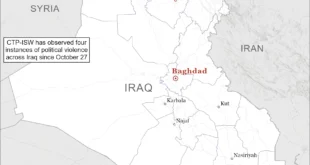What will happen if developing countries don’t have anything to export? This question will help us better understand the challenges that Iran will face during the next decade.
The main point in the arguments against Iranian Nuclear energy program has been that Iran is an oil-rich country and does not need nuclear energy. The fundamental question for some countries is that “why would Iran need peaceful nuclear energy, given its vast hydrocarbon reserves? Peaceful nuclear energy is not its ultimate objective.†i This question is correct only if Iran uses all its energy resources for internal consumption and can do so without any problem. But for different reasons such an action is not possible.  According to article IV of the Nuclear Non-Proliferation Treaty (NPT) the research, production and use of nuclear energy for peaceful purposes is an inalienable right of all countries without discrimination. However, the fundamental question is not about Iran’s right, it is about Iranian needs. Although Iran is an oil-rich country, for many reasons, developing peaceful nuclear energy is nevertheless essential for it. Economic, environmental, and social conditions of Iran make developing peaceful nuclear energy a necessity which is why even before the 1979 Revolution, Iran started such a program with US consent and has continued it since then.Â
Economically, Iran is a developing country with about 6 percent of GDP growth each year. For different reasons including industrial development, oil consumption in Iran has been increasing very fast. During the past decade the oil consumption in Iran has increased about 6.5 percent annually. Only in the last year Iran has consumed about 1.5 million barrels of crude oil a day.ii And it has spent 4 billion dollars to import gasoline. If the current trend of oil and gasoline consumption continues, not only an environmental catastrophe will take place, but Iran will also lose its oil export revenues by 2015.Â
As the Nuclear Energy Institute writes “Nuclear energy has a vital role to play in sustainable economic development around the world because it is emission-free and provides abundant, reliable, affordable electricity.” iii Electricity consumption in Iran is increasing at 8 percent annually. At present, Iranian electricity production capacity is about 39000 Megawatt and electricity consumption increase 8 percent each year, Iran will need more than 80000 Megawatt electricity power in 2015. Therefore, it is urgent for Iran to increase its electricity production capacity.Â
If we pay attention to the social situation in Iran, we will understand the consequences of such a development better. At present the Iranian population is about 70 million, 60 percent of which is under 30 years. Each year the government must create 1 million new jobs. By emphasizing the expansion of higher education during the past decade, Iran has only postponed the need for jobs. Therefore, at present unemployment is the main problem and even with current revenues due to increase in oil prices, Iran is still not able to create enough jobs. In 2015 Iran’s population will be more than 80 million. With decrease in and eventually loss of foreign currency revenues, what will happen in a country, the economy of which is 85% dependant on oil exports and which needs billions of dollars for investment and creation of jobs?Â
Environmental problems are another reason that most countries try to develop nuclear energy. “Its first use as a commercial energy source came about because it had obvious benefits for pollution control.”iv According to the 2005 Environmental Sustainability Index (ESL) – Scores and Rankings, Iran’s ESL score is 39.8. If this figure is compared with other countries, it will be easier to understand the situation. For example, Japan is industrially much more developed and its population density is much higher, but its score is 57.3. “The higher a country’s ESI score, the better positioned it is to maintain favorable environmental conditions into the future.”v From the point of view of nuclear energy production, after the United States and France, Japan holds third rank worldwide.Â
Based on this research, the air quality of Iran is -0.95; Water Quality is -0.69 and the Greenhouse Gas Emissions are -0.95. Poor ambient air quality affects both human and ecosystem health. The amount of NO2 in Iran is estimated at about 53.81, very high. “Humans exposed to high NO2 concentrations may suffer respiratory illness and lung damage. NO2 is also a precursor to the formation of ground-level ozone and acid rain.â€viÂ
Air pollution in many large Iranian cities has been very severe and even reached such dangerous levels that schools were closed and aged people asked not to leave their homes. In Tehran alone, it is estimated that more than 4000 people lose their lives every year because of air pollution. Furthermore, Environmental problems and air pollution are the main causes of many other diseases in this country.Â
In order to prevent more economic and social problems and environmental catastrophes, Iran has no alternative but to invest in clean energy technologies. Peaceful nuclear technology is the most important and reliable among all. Nuclear power plant projects are time consuming, so Iran needs to increase its efforts to prevent future challenges. The Iranian intention is clear: atoms for sustainable development. Developed countries, by investing in Iran’s peaceful nuclear programs and in oil and gas projects, not only will help Iran overcome its environmental, economic and social challenges, but also will contribute to the global economy and energy security.
Nabi Sonboli
References:Â
i U.S. State Dept. Daily Press Briefing October 4, 2005, http://www.scoop.co.nz/stories/WO0510/S00074.htmÂ
ii Iran, country analysis brief, http://www.eia.doe.gov/emeu/cabs/iran.html#envirÂ
iii Sustainable Development and Nuclear Energy, http://www.nei.org/index.asp?catnum=2&catid=315Â
iv Richard Rhodes, Nuclear Power’s New Day, New York Times May 7, 2001, http://www.world-nuclear.org/opinion/nyt090501.htm.Â
v 2005 Environmental Sustainability Index Report, http://www.yale.edu/esi/ESI2005_Main_Report.pdfÂ
Â
vi 2005 Environmental Sustainability Index, http://www.yale.edu/esi/c_variableprofiles.pdf
Â
 Eurasia Press & News
Eurasia Press & News



